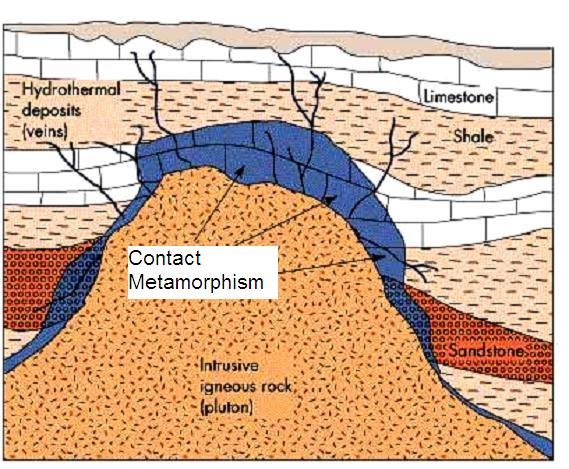
The magmatic deposits which are formed toward the late close of magmatic period are called late magmatic deposits.The late magmatic deposits contain those ore minerals which have crystallize at low temperature from a residual magma .
The late magmatic deposits are formed due to one of the following :

Residual liquid segregation:
In certain mafic magmas residual liquid gets enriched in Fe,Ti and volatiles and settle at the bottom of the magma chamber or crystallize in the interstices of the early formed crystal.
Residual liquid injection:
The iron-rich residual liquid accumulated in the above manner may be subjected to movement because of:
a. Gentle tilting (causing lateral movement).
b. Pressure and be squirted out to places of lesser pressure.
In both cases it may be injected into adjacent rocks and even in the earlier consolidated parent silicate mass.
Examples: Titanomagnetite Deposits, Adirondack Region, New York; Allard Lake Deposits; Magnetite Deposits of Kiruna, Sweden.
Immiscible liquid segration:
Sometimes magma of an ore-and-silicate composition breaks down during cooling into two immiscible fractions which accumulate to form liquid segregation deposits.
e.g. Sulphide minerals usually associated with platinum, gold, silver copper etc.
Immiscible liquid injection:
The immiscible liquid accumulations before consolidation when subjected to disturbances, get injected into the surrounding rocks, forming immiscible liquid injection.
eg. Nickeliferous Sulphide Deposit of Sudbury (U.S.A.).

Alteration and replacement of the country rock due to invasion of magmatic emanation is called contact metasomatism.
Deposits are usually calcareous.
Formation temp.: 400°-1000°c.
Operates at deep seated batholic masses of intermediate composition.
Eg.cassisterite,zinc,magnetite

Concentration of metallic minerals formed by precipitation of solids from hot mineral laden with water( hydrothermal solution).
Mostly arise due to action of deeply circulating water heated by magma.
Condition to form
1.Presence of hot water to dissolve and transport.
2.Presence of interconnected opening.
3.Availability of sites.
4.Chemical reaction results in deposition.

Formed towards the end of crystallisation.
Occurs close to the roof magmatic masses.
Forms between 500°-800°c.
The are of two types:
Simple: made up of potash feldspar and quartz.
Complex: different zones can be distinguished in the rock indicating differentiation.
Occurs in dykes and veins .

Associated with volcanism and fumaroles.
Sublimates deposited at or near the surface at low PT.
Due to sudden cooling of vapours emanating from volcanoes
✅ @bikrambaruah, I gave you an upvote on your post! Please give me a follow and I will give you a follow in return and possible future votes!
Thank you in advance!
Downvoting a post can decrease pending rewards and make it less visible. Common reasons:
Submit
Congratulations @bikrambaruah! You have completed the following achievement on Steemit and have been rewarded with new badge(s) :
Click on the badge to view your Board of Honor.
If you no longer want to receive notifications, reply to this comment with the word
STOPDo not miss the last post from @steemitboard:
SteemitBoard World Cup Contest - Let's go for the Quarter-Finals
Participate in the SteemitBoard World Cup Contest!
Collect World Cup badges and win free SBD
Support the Gold Sponsors of the contest: @good-karma and @lukestokes
Downvoting a post can decrease pending rewards and make it less visible. Common reasons:
Submit